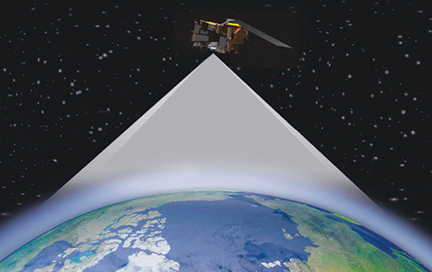
[SatNews] Airbus Defence and Space will be the European Space Agency’s (ESA’s) prime contractor for the development and construction of the high-precision Sentinel-5 instrument worth 144 million euros.

Artistic rendition of Sentinel-5.
Image courtesy of Airbus D&S.
The instrument will monitor the composition of the Earth’s atmosphere globally on a daily basis by taking measurements of trace gases and aerosols that have an impact on the climate and air quality.
“It is only with satellites and their instruments that we can observe the environment globally and continuously. ESA has entrusted us to take the Copernicus program forward by constructing the next key instrument, the high-precision Sentinel-5 spectrometer, at our optical space center in Ottobrunn, near Munich - Germany,” said Michael Menking, Head of Earth observation, navigation and science programs at Space Systems. “To date, we are already constructing three Sentinel satellites and various other Sentinel instruments for the Copernicus program that support a modern, efficient infrastructure for Earth observation and geo-information services. This demonstrates how our high-tech expertise serves global environmental monitoring as well as global security.” Sentinel-5 will be installed on a MetOP Second Generation (MetOP-SG) satellite and fly in a roughly 800 kilometer polar orbit around the Earth.
The high-tech instrument is expected to be delivered in 2019, while the launch of the satellite is scheduled for 2021. With a swath width of around 2,670 kilometers, the Sentinel-5 will provide daily global coverage of the Earth’s atmosphere with an unprecedented spatial resolution of 7x7km2 at nadir, allowing atmospheric and climate scientists to accurately detect and analyze emission sources. This includes determining the concentration of trace gases as significant components in the atmosphere, such as ozone, nitrogen dioxide, sulfur dioxide, methane, formaldehyde, carbon monoxide and aerosols. At the heart of Sentinel-5 is an ultraviolet, visible, near-infrared and shortwave infrared (UVNS) imaging spectrometer. This large spectral bandwidth is an absolute necessity for measuring the types of molecules named above.
The mass-optimized instrument, weighing around 270 kilograms and with a service life of more than seven years, consists of the optical module—comprising a reflecting telescope, a beam-splitter optical assembly, two ultraviolet/visible (UV-Vis) and one near-infrared (NIR) spectrometer optics as well as two shortwave infrared (SWIR) systems and a calibration subsystem—and two control electronics assemblies. Airbus Defence and Space is building a team of approximately 24 European suppliers for the development and construction of Sentinel-5.
Airbus Defence and Space has already constructed a large number of optical instruments that successfully operate on scientific, Earth observation and meteorological satellites. The company gained valuable experience from developing ERS-1 and Envisat, key European low-Earth orbit environmental satellites; the Sciamachy instrument for mapping the ozone layer and the development of the ozone hole; the Sentinel-4, a dispersive imaging spectrometer operating from geostationary orbit, as well as the Near-Infrared Spectrograph (NIRSpec), the major European contribution to the NASA James Webb Space Telescope (JWST).
For further information, access http://airbusdefenceandspace.com/

